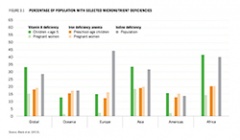The following story by Brenna Fitzpatrick was originally published on the Food Tank blog.
The 2014 Global Hunger Index (GHI) recently released by the International Food Policy Research Institute (IFPRI), Welthungerhilfe, and Concern Worldwide highlights the progress, shortcomings, and inequalities in the global fight against hunger. The report, released annually since 2006, documents hunger in 120 developing countries using three criteria: proportion of people underweight in a population, prevalence of underweight children under five, and the under-five mortality rate.
As the 2015 deadline for the Millennium Development Goals (MDGs) draws near, the GHI offers us an opportunity to evaluate the progress the global community has made towards achieving the MDGs, while also forcing the global community to confront how to best approach framing post-2015 development goals. The first goal (eradicate extreme poverty and hunger) called for a specific target of halving the proportion of people who suffer from hunger between 1990 and 2015; we have fallen short of that goal, having only reduced hunger by 39 percent.
Of the 120 developing countries profiled, hunger in 55 countries remains “serious” or worse, with 14 countries having “alarming” and 2 “extremely alarming” levels of hunger. The geographic distribution of these “serious” or worse countries is highly unequal, with the majority concentrated in sub-Saharan Africa and South Asia. However grim these figures, they signal a 39 percent reduction in worldwide hunger. Since 1990, 26 countries reduced their scores by 50 percent or more; 39 countries reduced their scores between 25 and 49.9 percent; 17 countries decreased their scores by less than 25 percent; while four countries – Swaziland, Iraq, Comoros, and Burundi – actually experienced a rise in scores. The Republic of Congo, Afghanistan, Somalia, Bhutan, Myanmar, Georgia, Oman, Belize, French Guiana, and Papua New Guinea were omitted from the report due to a lack of reliable data for those countries.
None of this, the report stresses, accounts for the more than 2 billion people suffering from “hidden hunger,” or micronutrient deficiency. Often overlooked and difficult to detect, micronutrient deficiency weakens the immune system, stunts physical and intellectual growth, and can even lead to death. Poor diet, increased micronutrient needs during certain life stages (notably pregnancy and lactation) and health problems such as diseases, infections, or parasites all exacerbate hidden hunger. Hidden hunger can also hinder economic development, causing a loss of productivity and reduced economic growth. The report puts the annual global lost economic productivity stemming from macronutrient and micronutrient deficiencies at a staggering $2 trillion.
The authors emphasize that tackling hidden hunger will require “long-term, sustained, and coordinated efforts” focused on the production of diverse crops and nutrient-rich foods. While in the short term, vitamin and mineral supplements can help, the brunt of the focus must be on food-based measured such as dietary diversification, fortification of commercial foods, and biofortification.
The report focuses on the intersectionality of the causes underlying hunger and calls for a multisectoral approach that promotes advances in agriculture, health, water and sanitation, social protection, education, and women’s empowerment. The authors of the GHI offer a number of policy recommendations, including prioritizing the elimination of hidden hunger, investing in human capacity building, enhancing accountability, and creating a regulatory environment that promotes adequate nutrition.
According to the authors of the GHI: “ending hunger in all its forms is possible. It must now become a reality.” We have the resources, knowledge, and productive capacity to completely eradicate hunger from our world – let’s do it.







